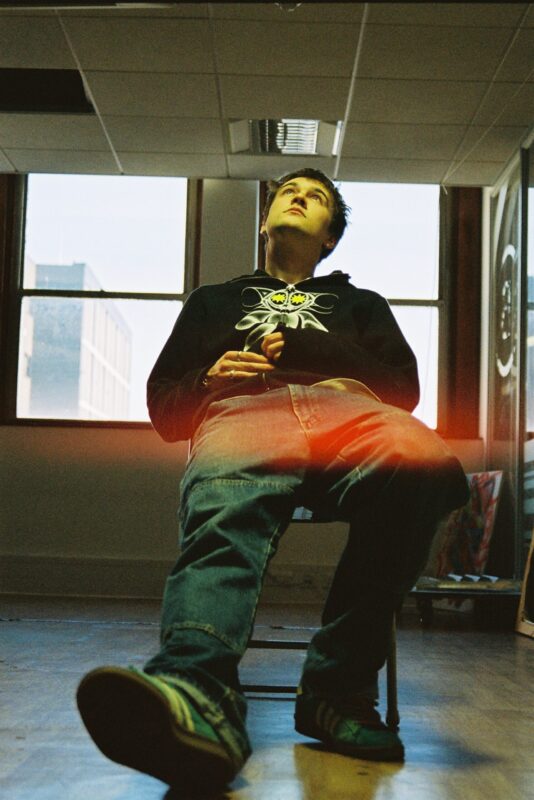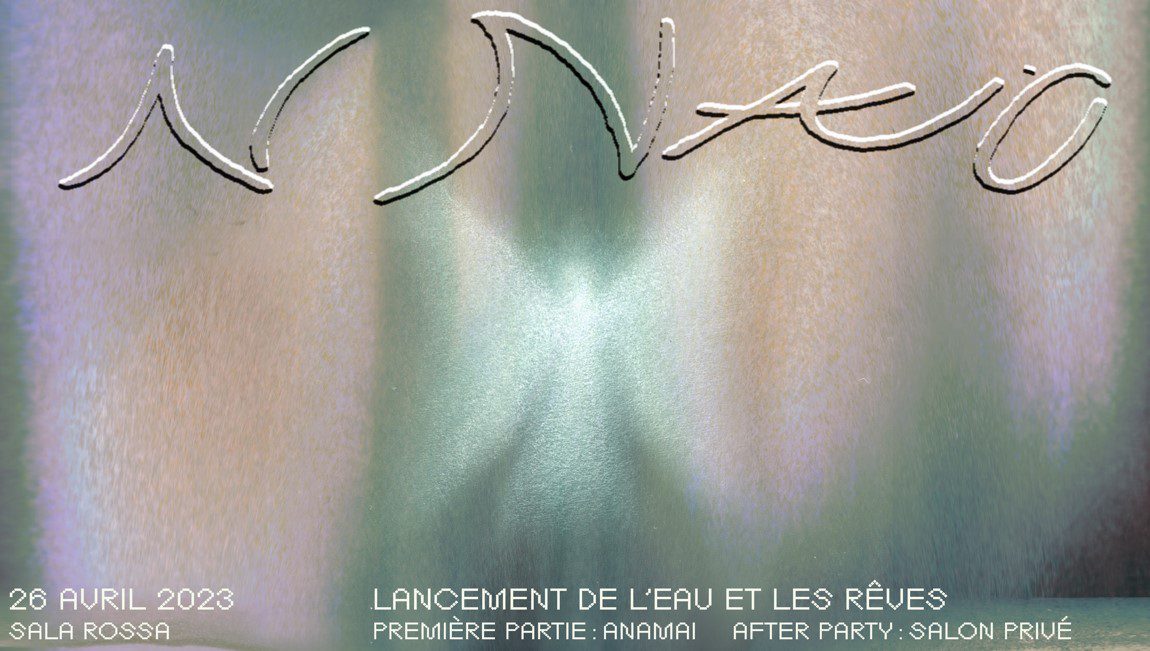SINNAZ is an international electronic music duo, composed of SIM, born and raised in Montreal and NAP, born in Bogota and now living between Montreal and Ciúdad de Mexico. The collaboration began as casual jam sessions, but over time their sound developed, their friendship grew, and they began to create songs.They join forces to unveil a 4 tracks debut EP exploring sounds, emotions and atmospheres from dancehall, dembow and bass music, out on the Vancouver label Isla, founded by NAP. With summer hopefully at the corner, their EP will definetely put you in a mood. PAN M 360 conducted an interview by email to dive into the life and projects of these two excellent producers and very active members of the electronic community.
PAN M 360 : Can you introduce yourselves, your background (related to music or not)?
SIM: I’m Sim Laporte, born and raised in Montreal, Canada. I’m part of a collective and community-based project called Mata Sound, which facilitates fertile grounds for creation, education and personal elevation. I have a background in Fine Arts and Community Art Education, making pedagogy an intrinsic part of my music and sound practice.
NAP: My name is Daniel Rincon. I was born in Bogota, Colombia and moved to Canada when I was 15. My roots in music come from being a music nerd in my teens working at a record store in Vancouver and going to all of the shows I could get into. These days I make music as NAP and a variation of collaborations with other friends and colleagues (Ambien Baby, Dosis, OSS, La Fe, SINNAZ). I also run the label Isla which I started in Vancouver back in 2016. Currently I live and work between Ciudad Mexico and Montreal.
PAN M 360 : Tell us how your collaborative project, Sinnaz, was born.
NAP: I heard SIMs record on Nervous Horizon when I was living in Berlin 2021 and wrote him saying how much I loved it. I shared some of the music I was making and releasing and it also resonated with him. Then when I got back to Montreal summer of 2021 we met for the first time at my studio and it was love at first jam. Real positive music nerd vibes, being open and sharing what we were excited about with each other. From then on we just kept getting together at my studio to hang and jam.
SIM: I can clearly remember being in the IKEA warehouse being overwhelmed by everything that was happening when I received an interesting email from a certain Mr. Rincon, saying that he would be moving in Montreal, and he wanted to work with me. Instantly intrigued, I accepted the offer and we met over a burrito before starting what eventually would be the first step toward SINNAZ.
PAN M 360 : This EP was created between 2021 and 2023, how did you work together as team and what can you tell us about your creative process (the easy parts and the more difficult)?
SIM: Being a fine Ableton connaisseur, and Daniel the MPC master, we naturally migrated to our respective tools within the studio to find a workflow that complements our expertise. I kind of set the first bleeps, then open the recording for Daniel to fiddle around the analog stuff. I would stop the jam to re-adjust and arrange things, and start the recording again! Little by little, we had enough tracks that would sound cohesive in a form of an EP.
I think the main challenge in our creative process is to find the time to work together. Both of us being extra busy with a multitude of on-going projects that gets us travelling around the world makes it difficult for us to be in the same room. But thats also what makes every session all the more meaningful!
NAP: SIM and I defined a nice flow to our studio dynamic early on our jams which became the focus of our process when making the record and something we want to keep developing in the studio. SIM is an ableton wizard so he usually sits at the helm of the mixer recording and mixing/ chopping the lines that i’m adding with gear. I’m usually darting around adding lines with different bits of gear. After recording a series of sounds and sequences (often around a simple loop/beat) we then sit and start cutting By this point we take 15-30 minute shifts tackling edits and arrangement duties, until an edit comes through. After arrangements are made SIM then mixes the tracks down.
As SIM mentioned, the biggest challenge to out process is finding the time to get together as Ive been living between Canada and Mexico the past year and with touring plus school schedules it makes it tough to land but special when it happens.
PAN M 360 : When and where in your musical journey did you fall in love with dancehall, bass and club music?
SIM: Like many of us, my earliest introduction to dancehall was through Sean Paul’s ‘Dutty Rock’ album. In 2003, I was too young to really grasp my head around Dancehall culture, but I always hanging out with older kids in my neighbourhood. I have a vivid memory of being in 1st grade, and I’m in the dance circle with 6th graders. ‘Get Busy’ is playing. To this day, I still relate to the kid in that music video. It’s later on in my music journey that I rediscovered Dancehall. My first point of entry in electronic music being Dubstep, it wasn’t long until I got into Dub, reggae and soundsystem music as well as UKG and club music as a whole.
NAP: For me it was Reggeaton, Rap and Champed that got me first. The sounds of Big Boi, Control Machete, El Chombo and Daddy Yankee were all playing on the radio growing up and were also the soundtrack to some of the first dances I went to. Eventually I would get into dancehall through my digging journey around 2015 when I got really into dub and its genre offspring. Lately I’ve found a lot of inspiration and joy in exploring the influences of Jamaican sound system culture across Latin American music; from providing us with the Dembow beat that would eventually give birth to the Reggeaton genre to influencing the Sonidero (Mexico) and Pico (Colombia) movements in South America – I’m deep in it right now, especially being around the Snider sound system culture in Mexico City currently.
PAN M 360 : What are the other things you have in common, beside your interest for electronic music?
NAP: I think we are both interested in things that are different yet very connected to music, like community and pedagogy. Especially with both of us sharing a background in art education, its always a pleasure to talk about music in that regard, a deeper concern for its sociocultural impact – oftentimes these conversations inadvertently end up informing the music making process anyways.
SIM: Exactly! Because music is an inherent part of us, it’s hard to be totally outside of it. Especially since music has the power to bring people together.
PAN M 360 : The EP is released on Isla, which is NAP’s – very prolific – label, can you tell me more about it? It was founded in Vancouver, are you originally from there? If so, what does the electronic music scene look like on the Canadian west coast?
NAP: Isla is a label I started in Vancouver in 2016. I bought a tape duplicator from a church in Abbotsford BC and started out dubbing out very limited runs of tapes from my studio, very much inspired by the punk and DIY ethos I grew up with. Since I’ve grown the label to include vinyl production but it’s still very much me releasing whatever feels right (often music and collaborations of mine or music from friends). As for the west coast electronic music scene, it had a very special nascent time in the early 10’s but I think that after much hype it sort of went sleepy… rightfully so as the scene was actually quite small. Personally, the west coast scene of the 80s and 90s seemed to me to be the most rich and full of lore (from Skinny Puppy to Exquisite Corpse to Pilgrims Of The Mind to Download to the Discotext crew) – Vancouver used to be cool!
PAN M 360 : Do you plan on performing as a duo (DJ or live set)?
SIM: Of course! If our schedule allows it haha! But we also have plans to perform, DJ and live with Ultima Esuna, for our project ‘Alta Familia’
NAP: Absolutely! At least some B2B DJ sets in Montreal this summer.
PAN M 360 : In Montreal, what are your favorite places (and crews) to go dance and listening to good music?
SIM: I recently went to Lulu Épicerie in Little Burgundy. AMAZING selection of early funk, disco and soulful house by the Beiroot Groove Assemble. Not to mention the entry comes with a free Shawarma? This place got the SIM stamp of approval!!!
NAP: I haven’t been in MTL the past year but I love playing records in the basement of Sans Soleil. I love the living room party vibes on a weekend there and it sounds great. Shout out Kris Guilty who books and rocks the spot (and also owns the best record store in town; La Rama)
PAN M 360 : Would you say Montreal electronic music scene is defined by language, meaning we can observe a French and an Anglophone side? How do you feel regarding this? Do you feel you have more ties to one side or another? How do you navigate those different spaces, audiences, etc.?
SIM: I think we live in a transitional time here in the Montreal scene. The way more and more artists from around the globe are coming and going around Montreal, I feel like the standard is in English within the Electronic Music scene. It’s hard for me to address this without turning it into a political statement, because of the History behind it, but one thing is for sure: Electronic Music in Montreal is defined by the people cultivating the scene, and its richness should be cherished.
PAN M 360 : What are the next big events/plans for each of you?
SIM: For me, big plans ahead are my tour in Europe, which I’m really excited about, and also Piknic Electronik this summer! Being on the same lineup as legends DJ Stingray and Helena Hauff is nothing but surreal.
NAP: I’ll be back in Montreal this summer with some small Euro tours across the year. Finishing some records I’m excited about (solo and collaborations) and putting out a couple more on Isla and ACA before the year is out.

